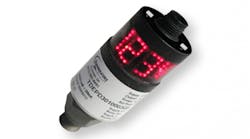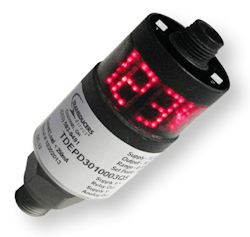Switching points and hysteresis are field programmable. The TDEPD switch incorporates redundant sensing elements, allowing for notification that the sensor needs to be replaced should one of the sensing elements fail (maintenance mode), eliminating operational downtime. The switch/transducer comes standard with one digital output and optional analog output. It operates from 10.5 to 28 Vac, and is IP67 certified.
Other specifications include ¼-in. NPT, 7/16-20 UNF, or G ¼ pressure port; 250 mA max (PNP) or 200 mA max (NPN) digital output; optional field-selectable analog output to 10 Vdc or up to 20 mA; and pressure ranges to 10K psig.
Transducers Direct, (513) 583-9491, www.transducersdirect.com
Click here to download a PDF datasheet of this product.


